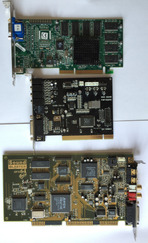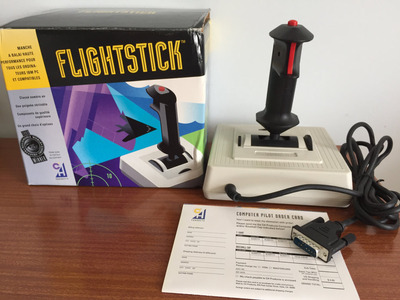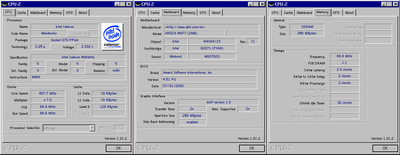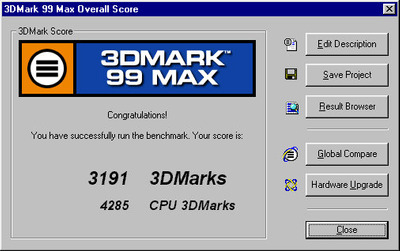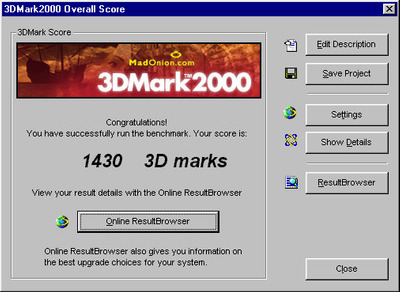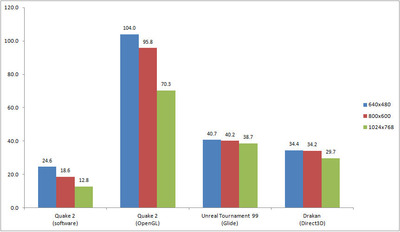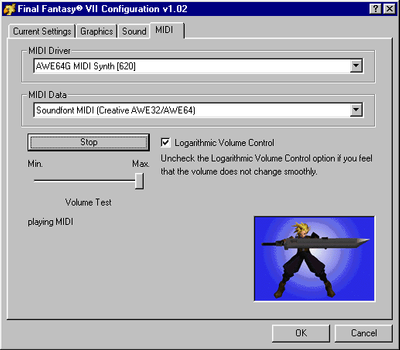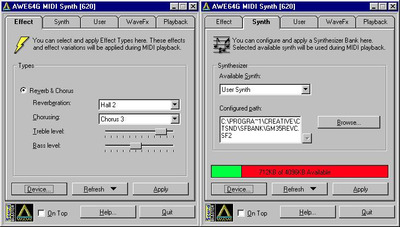First post, by Joseph_Joestar
- Rank
- l33t
Note: this system has now been retired, since I have other builds which are better suited for early and late Glide games. Some of the components will be moved to my other rigs, but I'm leaving the original specs and benchmarks here, for reference purposes.
System specs
- Intel Celeron 466 MHz
- Abit ZM6 (Intel 440ZX)
- 256 MB PC133 SDRAM (NCP)
- Voodoo 3 2000 AGP
- Sound Blaster AWE64 Gold (CT4390)
- Guillemot Maxi Sound Fortissimo (Yamaha YMF744B-V)
- NEC 3.5" floppy drive
- Kingston 120GB SSD + JMicron SATA to IDE adapter
- MSI 16x DVD-ROM
- Samsung SyncMaster 795MB CRT monitor
- LC Power 550W PSU (LC6550)
- CH Flightstick
- Roland SC-155
Note: several components of this system have been upgraded since I first posted this. The original specs can be seen here:
- Intel Celeron 466 MHz
- Abit ZM6
- 256 MB SDRAM
- Voodoo 3 2000 AGP
- Sound Blaster AWE64 Value CT4520
- Yamaha YMF724F-V
- NEC 3.5" floppy drive
- Quantum Fireball LCT20 hard disk
- Hitachi 24x CD-ROM drive
- Samsung SyncMaster 795MB CRT monitor
- Mercury 300W PSU
Introduction
This build is very similar to the computer that I had back in '99, but with some added extra features. Basically, I wanted a retro rig that can comfortably run DOS games from 1993 onward, while also offering solid performance in Win9x games up until the year 2000. A CRT monitor rounds up the build, providing a crisp image at lower resolutions. This matters since I'll be gaming mostly at 640x480 or 800x600 on this system, like I used to back in the day.
CPU
This Celeron 466 is a bit on the low end, but it still does a fairly decent job for Win98 gaming. Disabling the L1 and L2 cache via Setmul can slow it down to 386 levels which is nice for older speed sensitive games. With both caches disabled, the NSSI CPU benchmark ranks this processor around a 386DX at 25 MHz. On the other hand, if I need something more along the lines of an early Pentium, I use Throttle instead, and set the slowdown rate to 75%. NSSI ranks this slightly below a Pentium at 100 MHz, which is superb for games from the mid 90s. There are also some DOS games that crash due to too much ram, so I use XMSDSK & EMSDSK to lower the available memory to 32 MB which solves the issue.
Motherboard
The Abit ZM6 is a socket 370 board which can take Celerons up to 600 MHz with the latest BIOS update. It comes with 2 ISA slots which is very nice for experimenting with retro sound cards. Interestingly, this motherboard also has a SB-Link header which can improve the DOS compatibility of PCI sound cards that support it, including the Yamaha YMF744 that I used in this build. According to contemporary reviews, the Intel 440ZX chipset is a derivative of the ultra reliable 440BX, and seems to do equally well in the stability and compatibility department. It also comes with USB which allows me to connect a modern USB mouse and keyboard under Windows, and also use flash sticks for file transfers thanks to nusb.
Graphics card
I mainly use the Voodoo 3 to play Glide games of course, but it's also handy for other early Win9x games that rely on palletized textures and table fog. This card might be slightly bottlenecked by the CPU on this system, but I won't be playing in resolutions higher than 800x600 thanks to the CRT monitor, so that's not much of a problem. Under DOS, the Voodoo 3 offers a crisp 2D image and can even run some (but not all) early DOS Glide games. It also has fully functional drivers for Windows 3.1 for people who want to use that. When playing hi-res 3D DOS games in software mode (e.g. Quake and Tomb Raider) it's best to run FASTVID beforehand to further improve the frame rate. Lastly, the VBEHz tool can be used to force DOS games that use the 640x480 resolution (and higher) to utilize refresh rates greater than 60 Hz on a compatible CRT monitor. My Samsung SyncMaster 795MB can deliver 120Hz at 640x480 and 800x600, which makes games like Transport Tycoon and WarCraft 2 look very crisp.
Sound card 1: Sound Blaster AWE64 Gold (CT4390)
The AWE64 Gold is the primary DOS sound card on this system, and is mainly used for its AWE32 mode and SB16 capabilities. Its MT-32 emulation is also pretty decent for games that don't use custom instruments (e.g. Monkey Island 1). Most DOS games made in the later half of the 90s support the AWE32 mode directly and the earlier ones can be made to use it through General MIDI emulation, but only if they don't run in protected mode. Under Win98, the emulation is much better, and any game can access the wavetable through General MIDI. The AWE64 Gold has 4MB RAM on-board for loading soundfonts which can make General MIDI music sound even better in DOS games. The card is set up at A220 I5 D1 H5 P330 E620 T6 as that seems to provide the best compatibility. For FM synthesis, CQM is used since disabling it causes some games not to detect the card properly. However, if I want genuine OPL3 music, it's just a single click away thanks to the Yamaha card.
- AWE64 FM synth music samples (CQM)
- AWE64 wavetable music samples (AWE32 mode)
- AWE64 General MIDI music samples (default soundfont)
Sound card 2: Guillemot Maxi Sound Fortissimo (Yamaha YMF744B-V)
This is a very interesting sound card. Its Sensaura functionality is superb for A3D 1.0 games (e.g. Thief 1 and System Shock 2) where it offers positional audio on pair with an Aureal Vortex card. Sensaura also offers software emulated EAX 1.0 and 2.0 but that doesn't sound as good as proper, hardware accelerated EAX. Additionally, the Fortissimo has Digital Out via TOSLINK which makes it easy to record clean, noise-free audio from DOS and Win9x games.
The YMF744 also has one of the nicest sounding software wavetables under Win9x (see music samples linked below). It also supports Yamaha XG which can be used natively by some games such as Final Fantasy VII. In addition, this card has a genuine OPL3 core for FM synth music. In my build, the YMF744 is connected through SB-Link, so it has extremely good compatibility with DOS games, despite being a PCI card. Its SBPro compatibility complements the AWE64 nicely for those few games that can't produce stereo sound on a SB16 (e.g. Aladdin). It also tends to work without a hitch with very old games that don't detect the AWE64 as a sound blaster (e.g. Space Quest V).
Under Windows, the YMF744 resides under A240 I7 D3 P300. However, as per the instructions in this excellent video by Phil I made a PIF file called Yamaha on my desktop which starts a special MS-DOS mode session by loading custom AUTOEXEC.BAT and CONFIG.SYS files. Those have been configured to not use any of the AWE64 drivers. Therefore, the AWE64 remains uninitialized in this environment, while the Yamaha card acts as the primary sound blaster, now residing at A220 I7 D1 T4. This ensures maximum compatibility with older DOS games that expect the sound blaster to use IRQ 7 (e.g. Gods) while also providing proper SBPro compatibility and genuine OPL3 for FM synth.
Music samples:
- Yamaha FM synth music samples (OPL3)
- Yamaha General MIDI music samples (default soundbank)
- Yamaha XG music sample (digital out)
Conclusion
I had a lot of fun making this build, carefully picking and choosing components to bring out its strengths and work around its limitations. In particular, I'm the very pleased with how I ended up using SB-Link and Sensaura to bring out the best qualities of the YMF744. All in all, I'm very happy with the end result and will be using this rig quite frequently for retro gaming. This system does cover a lot of bases, but it lacks hardware EAX support and 32-bit color rendering in 3D games. Those tasks will be handled by my AthlonXP rig which is much more powerful.

